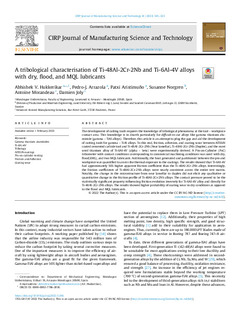Title
A tribological characterisation of Ti-48Al-2Cr-2Nb and Ti-6Al-4V alloys with dry, flood, and MQL lubricantsPublication Date
2023Other institutions
Lund UniversityAdvanced Assisted Manufacturing Solutions
Version
Published versionDocument type
Journal ArticleJournal ArticleLanguage
EnglishRights
© 2022 The AuthorsAccess
Open accessPublisher’s version
https://doi.org/10.1016/j.cirpj.2022.11.016Published at
CIRP Journal of Manufacturing Science and Technology Vol. 41Publisher
ElsevierKeywords
gamma titanium allumide
Ti-6Al-4V
Tribology
AlTiSiN coatings ... [+]
Ti-6Al-4V
Tribology
AlTiSiN coatings ... [+]
gamma titanium allumide
Ti-6Al-4V
Tribology
AlTiSiN coatings
Pin-on-cylinder testing
Friction and Adhesion
Coating wear [-]
Ti-6Al-4V
Tribology
AlTiSiN coatings
Pin-on-cylinder testing
Friction and Adhesion
Coating wear [-]
Abstract
The development of cutting tools requires the knowledge of tribological phenomena at the tool – workpiece contact area. This knowledge is in dearth particularly for difficult-to-cut alloys like gamma ... [+]
The development of cutting tools requires the knowledge of tribological phenomena at the tool – workpiece contact area. This knowledge is in dearth particularly for difficult-to-cut alloys like gamma titanium aluminide (gamma – TiAl alloys). Therefore, this article is an attempt to plug the gap and aid the development of cutting tools for gamma – TiAl alloys. To this end, friction, adhesion, and coating wear between AlTiSiN coated cemented carbide tool and Ti-48Al-2Cr-2Nb (Near lamellar), Ti-48Al-2Cr-2Nb (Duplex), and the most used titanium alloy of Ti-6Al-4V (alpha – beta) were experimentally derived. A Pin-on-Cylinder (PoC) tribometer with contact conditions corresponding to commercial machining conditions was used with dry, flood(EML), and two MQL lubricants. Additionally, the heat generated and partitioned between the pin and workpiece was quantified to assess the thermal exposure to the coatings. The results showed that Ti-6Al-4V had approximately 50% higher apparent friction coefficient than the Ti-48Al-2Cr-2Nb alloys. Interestingly, the friction coefficients of Ti-48Al-2Cr-2Nb alloys were nearly consistent across the entire test matrix. Notably, the change in the microstructure from near lamellar to duplex did not elicit any qualitative or quantitative change in the friction profile of Ti-48Al-2Cr-2Nb alloys. The contact pressure proved to be the statistically significant property influencing friction evolution inversely for Ti-6Al-4V alloy and directly for Ti-48Al-2Cr-2Nb alloys. The results showed higher probability of coating wear in dry conditions as opposed to the flood and MQL lubricants. [-]
Collections
- Articles - Engineering [763]
The following license files are associated with this item:






















